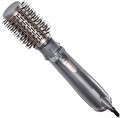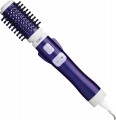Power/temperature control
—
Joint. In models with joint adjustment of power and “degree” of air flow, the parameters change at the touch of a button. Hair dryers usually have several fixed values of blowing intensity and air temperature.
—
Separate. Separate heat and temperature controls give you more freedom of choice when using your hair dryer and styler. The parameters of the flow force and temperature for hair dryers with separate adjustments change separately, which allows you to count on the optimal values of power and “degree” of blowing to avoid overdrying your hair.
Brush diameter
The diameter of the brush used in the corresponding tool (see “Device”), more precisely, the diameter of the cylinder from which the brush hairs “grow”.
For different hair lengths, different types of hairstyles and styling methods, the optimal sizes of brushes will also be different — in some cases, a small diameter, 20 – 25 mm, is more convenient, in others large brushes of 30 mm or more will be more convenient. However, this parameter is relevant mainly for professional use and work with long hair, complex hairstyles, etc. If the tool is bought for normal household use without any frills, the diameter of the brush is not so important.
Coating of the heating element
Type of outer coating of the heating element.
— Chrome plated. The most basic and widely used coating option is chrome. It is affordable and heats up quickly. However, using chrome-coated heaters can pose a higher risk of hair damage, so caution is needed when using them. Due to this risk, chrome-coated nozzles are not ideal for frequent or continuous use.
—
Aluminium. Such heaters are considered more advanced than the chrome ones described above, due to a longer service life and better heat distribution. However, it is not without the characteristic drawbacks of any metal coating, primarily the negative impact on the condition of the hair.
—
Titan. Another option for a metal heater. In terms of basic properties, it is almost completely similar to aluminium (see above), in most cases it differs only in appearance.
—
Ceramics. The main advantage of ceramics is the better distribution of heat than in metal heaters. Due to this, such a coating is considered much more “gentle”; however, its cost is noticeably higher, and heating is slower.
—
Tourmaline. In most cases, when referring to a ceramic heater, it is typically combined with a tourmaline coating. This coating serves two primary functions: ionization, which promotes smooth and even styling, and friction reduction, allowing the cur
...ling iron to glide through the hair effortlessly.
— Titanium ceramics. A specific type of ceramic coating used by some manufacturers. The design, usually, implements various additional technologies designed to improve the quality of work; however, whether such devices outperform "ceramic" analogues depends on the model in each specific case.
— Titanium-tourmaline. An analogue of the tourmaline coating described above, in which titanium is used as the base of the heater instead of ceramic. There is practically no difference in the main features.
— Steel. The most basic and common coating option is "ordinary metal plating," typically referring to steel. The main advantage of this surface is its low cost. However, the heating can be uneven and harsh, which demands careful handling of the tool and makes it less suitable for frequent use.
— Teflon. Teflon stands out for its low friction, making plates glide effortlessly through the hair, even more so than ceramic ones. However, in terms of heating uniformity, it slightly lags behind ceramics.
— Copper silicon. Typically, the reference is made to silicon-coated copper plates. Copper offers excellent thermal conductivity, ensuring uniform heating, while silicon provides practical properties similar to ceramics, such as a gentle effect and suitability for frequent use. However, this option is relatively specific and does not offer significant advantages over more traditional materials, which is why it is relatively rare.
— Manganese-copper. The manganese-copper coating on the heating plates offers a very gentle effect on the hair. These flexible plates allow the styler (straightener or curling iron) to adapt to the shape of the hair strand, reducing mechanical stress on the hair and minimizing damage. As a result, the hair becomes more manageable and obedient.Functions
—
Turbo mode. A mode designed to dry wet hair as quickly as possible. At the same time, the speed of air movement through the hair dryer increases significantly, and the temperature remains the same. This allows you to quickly dry your hair without exposing it to high temperatures. Working in turbo mode usually involves an increased load on the device, so before using such a hair dryer, you should separately clarify in the instructions for what maximum time you can turn on turbo mode.
—
Auto-rotation of the nozzle. The function of automatic rotation of a brush or other round nozzle (see "Nozzles"). Thus, the user gets rid of the need to turn the entire device when styling hair, which may not be very convenient. Note that with long hair this function should be used very carefully, as there is a risk of entangling them instead of styling.
—
Cold air. The ability of the hair dryer to work without the use of a heating element — when the air flow has the same temperature as the surrounding air. This mode will be useful for drying weakened hair, especially sensitive to overheating. In addition, it can be useful during styling — in particular, cold air “fixes” the finished hairstyle.
—
Ionization. An ionizer is a device for saturating the air with negatively charged oxygen ions. Optimizes styling, giving hair new posi
...tive properties — for example, increased smoothness. Also, the hair is not electrified thanks to the ionizer.
— Steam humidifier. Some hair styling devices may be equipped with a container for liquid and a device that delivers hot steam to the hair. In this case, both ordinary water and a special styling liquid can be used. It is believed that the use of steam greatly facilitates the styling process, as the hair becomes more manageable. On the other hand, the high temperature of the steam can adversely affect the health of the hair, especially if the hair is weak or steam styling is used frequently.
— Alert timer. Devices with a built-in timer that makes audio signal after a set time. This function is relevant in stylers and curling irons, which allows the same time to curl curls. As a result, the hairstyle will have the same curls — there will be no imbalance in the curls when one turned out more and the other less.
— Automatic switch-off. A mechanism that ensures that the device turns off either after a specified period of time, or when a predetermined (or manufacturer-defined) temperature is reached. Prevents excessive heating of nozzles/plates, as well as overheating of the device in general.
— Key lock. The presence of a protective function of blocking the buttons allows you to avoid accidental pressing in the process of working with the device.Hanging loop
A special loop that allows you to hang the device on a nail, hook or other similar device. In some cases, this storage method is the most convenient — for example, a hair dryer or curling iron can be kept on the wall near the mirror, in front of which hair is usually dried and styled, while the device will always be at hand and will not take up space on shelves or in drawers. The loop is most often located directly on the power cord, near the handle.
Cord twist 360°
The connection point of the current-carrying wire to the body of the device is equipped with a swivel, so that the wire can freely rotate around its axis.
360˚ swivel of the cord allows you to increase the comfort of using equipment. After all, the wiring stops twisting into a knot. The swivel connection allows you to freely manipulate the device, using it from both the left and right sides.
Cable length
The length of the cord for connecting to the network, provided in the design of the tool.
The long cord provides greater freedom of movement, which is particularly beneficial in hairdressing salons and beauty establishments where professionals need to move around their clients. However, for regular household use, excessive cord length can lead to inconvenience, as it may get underfoot or cause other issues. A cord length of 1 – 1.5 meters is generally sufficient for home use. On the other hand, for professional tasks, tools with a cord length of 1.8 meters or more are commonly available.

